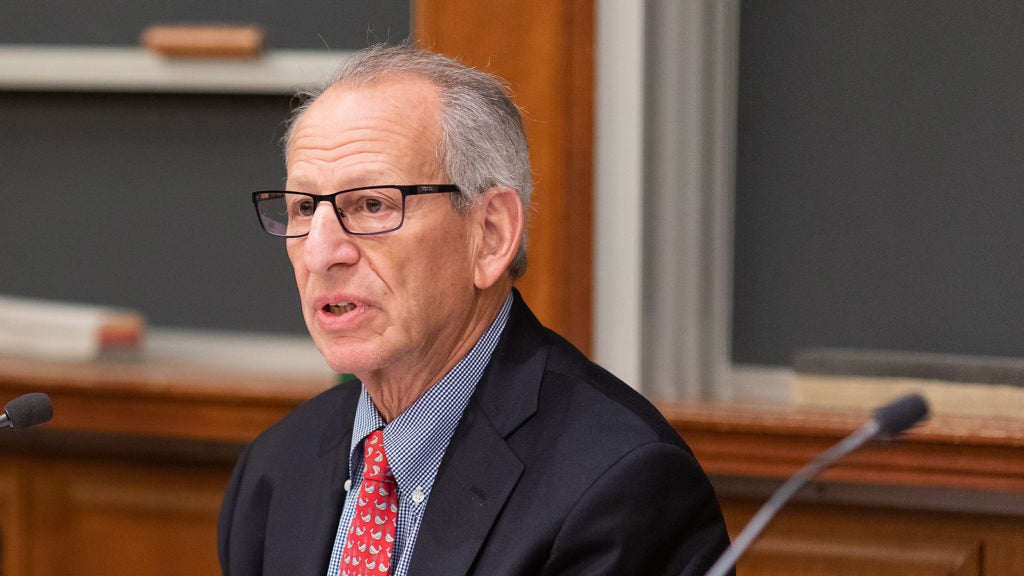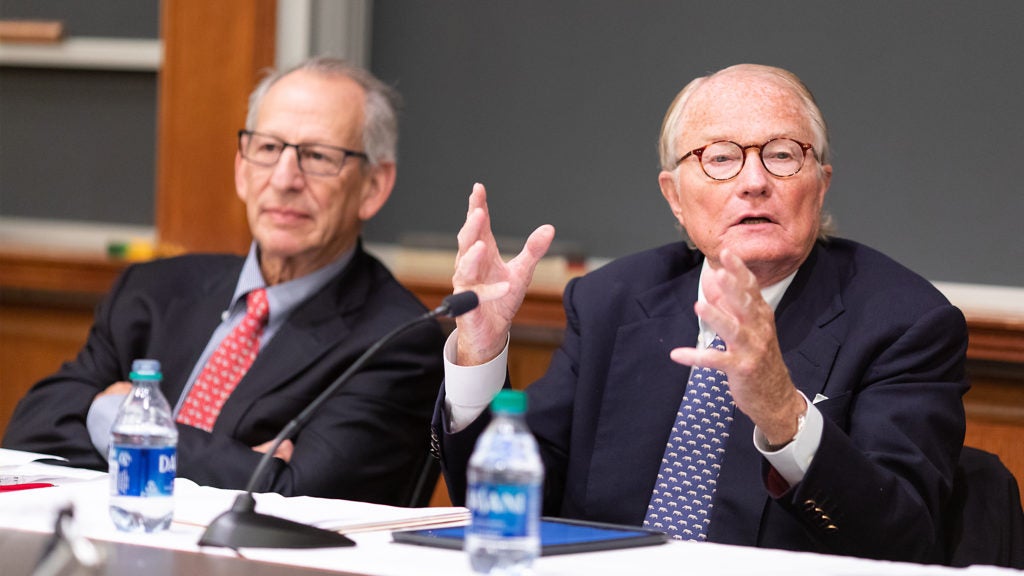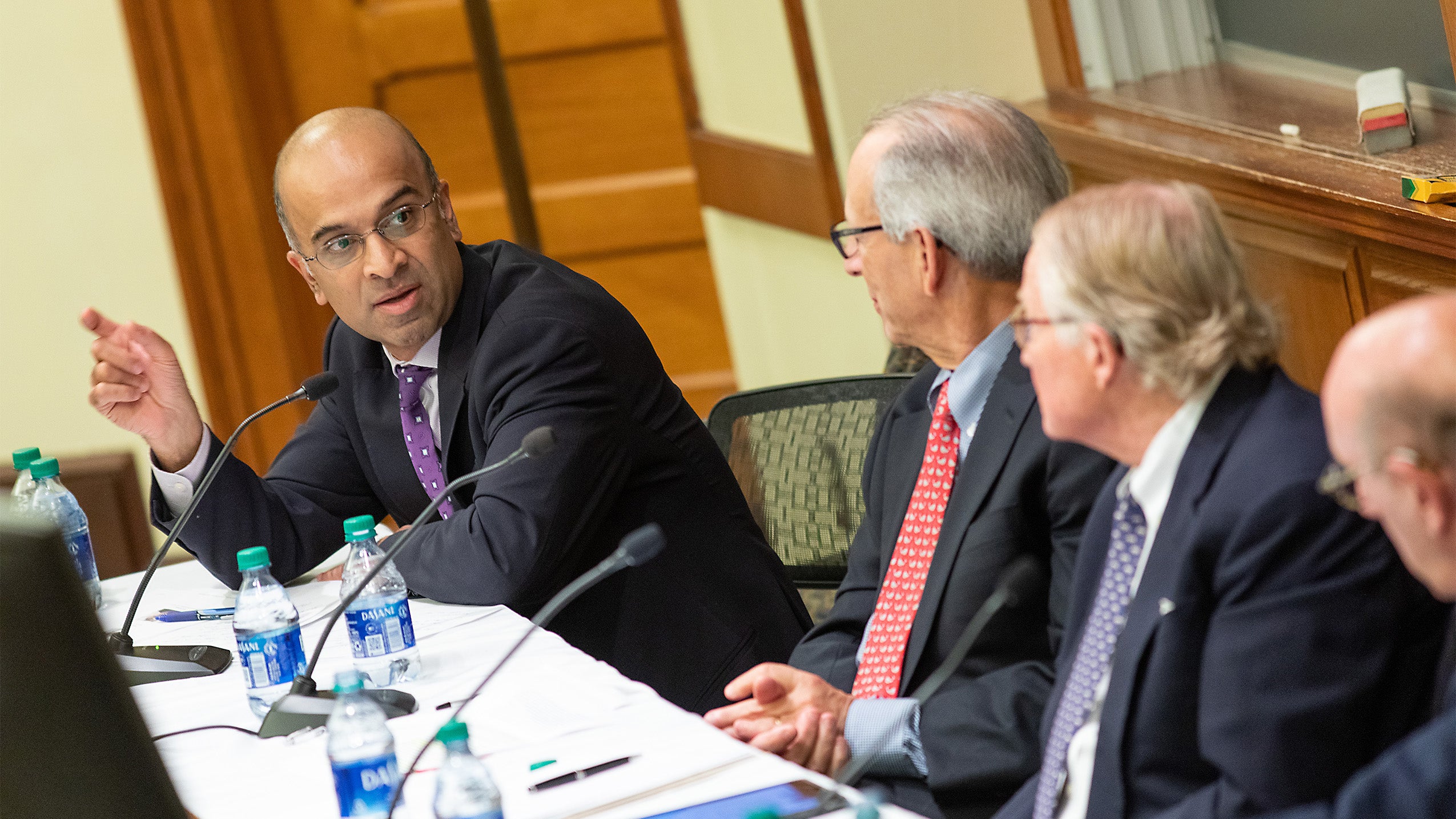Everything seems bigger in the late 20th and early 21st century, including the potential for widespread harm. With the advent of sweeping disaster comes the complicated question of how properly to compensate the victims.
A panel, “Innovative Models for Resolving Disputes after Mass Disasters and Catastrophic Harms,” held at Harvard Law School on Oct. 22, brought together three experts who have helped resolve disputes after recent historic catastrophes. Moderated by Harvard Law Professor Guhan Subramanian ’98 and sponsored by Harvard Law School’s Program on Negotiation, the panel included attorney Kenneth Feinberg, who famously served as special master of the 9/11 Victim Compensation Fund; Duke University professor Francis McGovern who has litigated cases regarding the BP oil spill and the opioid crisis, and Eric Green ’72 who founded Resolutions LLC, a mediation firm in Boston.

Eric D. Green ’72, founder of Resolutions LLC, a mediation firm in Boston that specializes in mediating and arbitrating complex multi-party cases, discussed the history of dispute resolution.
Green opened the talk with an historical overview, saying that the legal system is in an important period of transition. He broke legal history down into three stages, the first being the “eye-for-an-eye” system of prehistoric times. The second, “adjudicatory” stage, began roughly with the trial of Orestes for killing his mother Clytemnestra in Greek mythology, and the trial system has survived nearly to the present. Only recently have we entered a third, “consensus” stage, he said, where trials become rare and mediation becomes the norm.
“One aspect of the extraordinary advance in the speed and size of almost everything is the possibility of injury being inflicted on thousands of people before we even know it,” he said. From bank failures to terrorist attacks, Green said it can be difficult for conflict resolution to keep up with these developments. “Our courts and judges are trying, but the center will not hold,” he said.
“The 9/11 fund was absolutely the right thing to do, an innovative response to a national horror. But you’ll never see that again, it was one for the history books rather than the legal books.”
Kenneth Feinberg
Green cited a number of other recent cases that involved mass payouts, including Takata’s billion-dollar airbag case and the mortgage-backed securities crisis. “These cases are different, but they have one thing in common: They all exceed the capacity of our existing legal system on its own to resolve them. A high degree of innovation is required … and those are the questions that keep me awake at night.”
McGovern responded by citing one case he worked on, where an innovative solution proved workable. This was the Station nightclub fire in Warwick, RI, in February 2003. One hundred people were killed in the fire and another 230 injured, leaving the problem of how to compensate hundreds of survivors and families of victims. His team adopted an approach that had been used in Hawaii, when a dam failure in Kauai left hundreds of property owners suing for damages. In the Station case, a settlement amount was determined and the plaintiffs agreed to be bound by the results of a supermajority vote to accept it. Payouts for wounded plaintiffs were also calculated based of previous awards in wrongful death cases. (The settlement ultimately totaled $30 million.)
But, he admitted, it’s less certain that the same approach can work in current negotiation over opioids. “It’s different from the normal mass tort because there are many different defendants. When you have on one side nineteen thousand cities and municipalities, and roughly 15 million national defendants, how are you going to put a number on that?”

Duke Law Professor Francis McGovern (right), who has litigated cases regarding the BP oil spill and the opioid crisis, with Eric D. Green ’72, a law professor at Boston University from 1977 until 2008.
Feinberg said that each of the landmark cases he’s been involved with—including the 9/11 fund, the Boston Marathon bombing, and the BP oil spill in Louisiana—changed the equation in a different way. The Marathon fund, he said, was essentially a gift, prompted by unique circumstances: Mayor Tom Menino raised money and gave it to the victims, who were still free to sue. In contrast, the BP case was an alternative to the tort system: the plaintiffs took money and signed a release that stated they wouldn’t sue. The innovation here was in the size of the case: “We had 1,250,000 claims, from 50 states. I didn’t know the oil even got to Massachusetts.”
The size and scope of the 9/11 fund, which used taxpayer money to compensate victims, was unprecedented, but presented problems of its own—including survivors of other disasters who contacted Feinberg to ask where their own check was. “The 9/11 fund was absolutely the right thing to do, an innovative response to a national horror. But you’ll never see that again, it was one for the history books rather than the legal books.” Such solutions, he said, became necessary because the traditional court system isn’t equipped to deal with Rule 23 class actions at such a large level. “The courts could change this overnight, but they’re ill-equipped to deal with such a mass volume. They would need to come up with some innovative Rule 23 law.”

Kenneth Feinberg has been involved in a number of landmark dispute resolution cases, including serving as special master of the U.S. government’s September 11th Victim Compensation Fund and as the government-appointed administrator of the BP Deepwater Horizon Disaster Victim Compensation Fund. He is currently overseeing compensation funds for victims of clergy sex abuse.
During the discussion afterward, Subramanian asked if empathy plays a role in these negotiations. “It is the key,” replied Feinberg, citing recent work he’s done with survivors of abuse in the Catholic church. “One constant is that the victim who was abused as a minor, and is now 34 or 35, always wants to see me—not to complain about the compensation. They want validation, they want acknowledgement. They want someone to say, ‘I believe you, you have been wronged. You’re getting money and we know that isn’t enough’.”
In a revealing moment, McGovern said that empathy can be a two-way street, and gave Feinberg’s personal evolution as an example. “I think 9/11 changed Ken. When I first met him I didn’t like him, but after 9/11, I did.” He then revealed that a movie is now being made with Michael Keaton playing Feinberg. “You watch that movie, and you will see Keaton change.”
